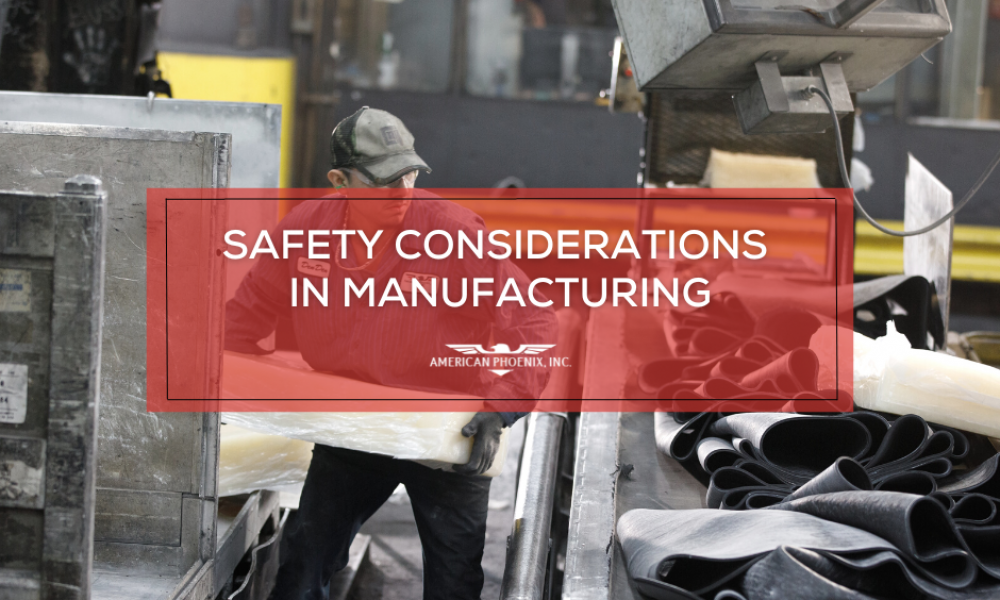If you visit our manufacturing facility, you will undoubtedly see a lot of brightly-colored personal protective equipment and signs to remind employees of proper operating policies and procedures. This is done to help maintain a safe environment for anyone who steps foot in the plant and avoid unnecessary incidents.
Safety is paramount in the manufacturing industry, as it can often be more physically dangerous than many other jobs. While it may seem like a lot of extra time and effort to follow proper safety procedures, reducing risks can help limit workplace accidents and serious bodily injuries.
Identify Potential Hazards
Identifying hazards is the first step in creating a safe work environment. In most manufacturing plants, many potentially dangerous elements exist, including machinery and equipment, chemicals, heat, noise, and ergonomic issues. Conducting thorough risk assessments to identify potential safety concerns is crucial. This involves evaluating each step of the process and identifying potential harm or injury sources. Once identified, appropriate measures should be implemented to mitigate or eliminate these hazards.
Provide Proper Equipment and Training
Implementing safety guards on machinery, providing proper personal protective equipment (PPE) such as gloves, goggles, and hearing protection, conducting regular equipment maintenance, and ensuring proper ventilation and exhaust systems are in place is the most effective way to reduce potential risks to employees. Proper training on the use of machinery, handling of chemicals, and other safety protocols should also be provided to all team members to ensure they are confident in their abilities to perform job tasks safely.
Design Tasks and Workspaces for Efficiency
Ergonomics is essential in planning manufacturing processes, as it involves designing workstations and job responsibilities to minimize strain on employees’ bodies. Typical in many factory and warehouse settings, tasks such as lifting heavy materials, repetitive motions, and prolonged standing or sitting strain employees’ bodies and may lead to musculoskeletal disorders or other injuries. Ensuring that workstations are ergonomically-designed, providing appropriate moving equipment, and teaching proper lifting techniques can help prevent accidents and promote physical safety.
Maintain a Clean and Organized Environment
Ensuring employees maintain clean and organized workstations is crucial for preventing trips, slips, and falls. You can help avoid accidental injuries by encouraging team members to store materials properly, clear walkways, and promptly address spills or other hazards. Employees should also be extra mindful when working with flammable chemicals and materials and understand how to handle and dispose of them to avoid fires properly.
Prepare for Emergencies
In addition to optimizing everyday tasks, it is also essential to be adequately prepared for emergencies. This includes having clear procedures for responding to fires, chemical spills, injuries, and other unanticipated situations. Regularly conducting drills and proactively training employees on emergency response procedures can help ensure that everyone knows what they should do if various circumstances arise. Having easily-accessible emergency exits, fire extinguishers, first aid kits, and other safety equipment readily available throughout the facility is also essential.
Encourage Employee Involvement and Communication
Effectively creating a culture that promotes safety also involves engaging employees and promoting open communication. Team members should be encouraged to report any concerns, near-misses, or incidents they observe in the workplace. Regular meetings, training sessions, and reminders can reinforce proper practices and keep safety in mind for all employees. Additionally, involving employees in developing and reviewing safety policies and procedures can promote a sense of ownership and commitment to mitigating potentially dangerous situations in the workplace.
At API, the safety of our employees is our top priority. The rubber manufacturing processes can be complex and involve various risks, so it is essential to have robust safety measures in place to protect our workforce. We are proud to provide extensive training and proper equipment to ensure our team members have a safe and comfortable working environment to create our superb products.
To learn more about manufacturing jobs, check out Top Seven Reasons to Work in Manufacturing and The Beauty Behind Blue-Collar Work.
For more articles From the Plant, check out our blog.




